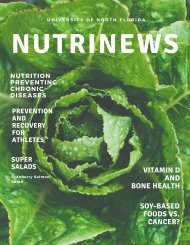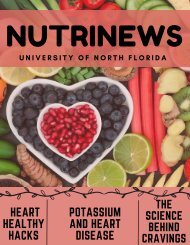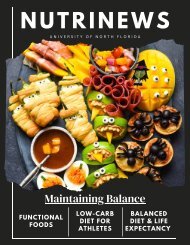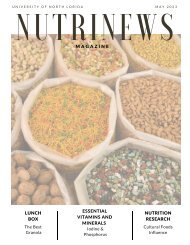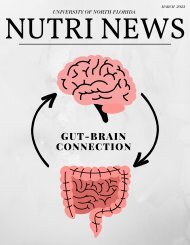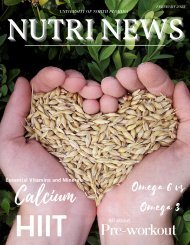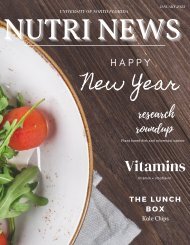November Issue 2023
This month's issue focuses on a variety of topics regarding organic and conventional foods. The issue highlights research on both organic and conventional foods, green zones, and so much more!
This month's issue focuses on a variety of topics regarding organic and conventional foods. The issue highlights research on both organic and conventional foods, green zones, and so much more!
Create successful ePaper yourself
Turn your PDF publications into a flip-book with our unique Google optimized e-Paper software.
NutriNews<br />
University of North Florida
TABLE OF CONTENTS<br />
“WEAR GRATITUDE LIKE A CLOAK, AND IT WILL<br />
FEED EVERY CORNER OF YOUR LIFE.”<br />
-RUMI<br />
04.<br />
NUTRITION RESEARCH<br />
History Behind Organic Foods<br />
09.<br />
LUNCHBOX<br />
Baked Pumpkin Oatmeal<br />
10.<br />
MONTHLY HACKS<br />
Organic vs. Nonorganic Products<br />
12.<br />
MYTH BUSTING<br />
Truth Behind Eggs<br />
17.<br />
TOPIC OF THE MONTH<br />
Green Zones and Green Spaces<br />
22.<br />
VITAMINS AND MINERALS<br />
Nutrient Composition of Organic<br />
Foods<br />
NUTRINEWS STAFF<br />
27. Meet the Team
N U T R I T I O N R E S E A R C H<br />
The Brief U.S.<br />
History Behind<br />
Organic Produce<br />
B Y : T A V I A N N A B R O O K S<br />
The organic food industry has been<br />
booming in popularity over the past few<br />
years.1 In 2020, organic sales achieved<br />
over 53 billion dollars in sales.1 Many<br />
consumers gravitate towards organic<br />
food due to health and environmental<br />
reasons.1,2 However, the history behind<br />
organic produce may be unknown to<br />
consumers.<br />
In 1859, the Colorado potato beetle’s first<br />
major outbreak severely damaged<br />
potatoes west of Nebraska.3 Over the<br />
next 15 years, the beetle migrated<br />
eastward of the U.S, damaging east coast<br />
potato crops and then Canada.4<br />
In the 1860s, Paris Green, a combination of<br />
arsenic and copper sulfate, was used as<br />
pest control against the Colorado potato<br />
beetle.3,5 This marked the beginning of<br />
the use of synthetic chemicals as<br />
pesticides.6<br />
4
N U T R I T I O N R E S E A R C H<br />
From 1862 to 1875, the first<br />
American agricultural revolution<br />
instigated the rise of agricultural<br />
legislation,, replacement of the<br />
slave plantation system for<br />
sharecropping in the South, and<br />
use of horses.7,8<br />
In 1862, Abraham Lincoln<br />
established the U.S. Department<br />
of Agriculture to support the 90%<br />
of Americans who were<br />
farmers.7,8 He nicknamed it “the<br />
people’s department.”8<br />
By 1867, Paris Green became<br />
widely used.3,6<br />
In 1873, a German student<br />
invented DDT,3 but its use in<br />
American agriculture was not<br />
seen until decades later.7<br />
In 1874, the availability of barbed<br />
wire to farmers restricted the<br />
grazing of cattle.7<br />
In 1890, the First Federal<br />
C L A U D I A A L V E S<br />
Inspection Meat Act was<br />
passed.7 This law was passed in<br />
response to competition in the<br />
foreign livestock market, where<br />
other countries inspected their<br />
animal products.9 However, the<br />
law only required pork and bacon<br />
to be inspected.9 It was later<br />
amended in 1891 to include all<br />
cattle intended for exportation.9<br />
In the late 1800s, U.S. imperialism<br />
introduced pests.3,5<br />
5<br />
In 1906, the Food and Drug Act<br />
was passed.7 It banned<br />
misbranding and adulteration of<br />
food.10 The Bureau of Chemistry<br />
(replaced later by the Food and<br />
Drug Administration) investigated<br />
deception, sampled food<br />
products, and took legal action<br />
against companies.10<br />
In 1910, the Federal Insecticide Act<br />
(FIA) was passed to ensure<br />
farmers and consumers were<br />
protected from adulterated and<br />
fraudulent pesticides sold by<br />
companies.6<br />
In 1936, the Soil Conservation and<br />
Domestic Allotment Act was<br />
passed, allowing the government<br />
to pay farmers to decrease<br />
production in an effort to<br />
conserve soil, limit erosion,<br />
protect water quality, and other<br />
environmental and public health<br />
reasons.7,11<br />
In 1942, Pyrethrin, a pesticide<br />
typically made from<br />
chrysanthemums, became<br />
unreliable when foreign production<br />
of chrysanthemums fell short.12<br />
In 1943, the U.S. was looking for<br />
other options regarding pesticide<br />
use to help meet food supply<br />
demands.12<br />
In the 1940s, DDT, one of the first<br />
modern pesticides, became widely<br />
used during World War 2.3,5 DDT<br />
was used to lessen insect-borne<br />
human diseases, such as malaria,<br />
and increase insect control among<br />
civilian and military populations.6<br />
Its use was also beneficial during<br />
wartime because it was cheap,<br />
easy to apply, and reliable.5 DDT’s<br />
use became widespread in the U.S.<br />
and other countries, resulting in<br />
pesticide-resistance among many<br />
insect species.13
N U T R I T I O N R E S E A R C H<br />
She highlighted pesticide residue found in food,<br />
pests growing resistance, and adverse<br />
agroecological affects.3 The book gained<br />
nationwide popularity, increasing advocacy for<br />
stricter environmental regulations and the<br />
banning of pesticides.5<br />
In 1969, the National Environmental Policy Act<br />
(NEPA) was passed.16 The law forced federal<br />
agencies to consider the environmental impact of<br />
their actions and decisions.16<br />
Add a 1945 to 1970 saw the second American<br />
agricultural revolution, introducing increased<br />
yields and “more specialized, capital-intensive<br />
farms.”14<br />
In 1947, the FIA was amended and renamed as<br />
the Federal Insecticide, Fungicide, and<br />
Rodenticide Act (FIFRA).6 FIFRA required all<br />
pesticides in the U.S. to be registered by the EPA,<br />
and it required that proof be provided that the<br />
pesticide “will not generally cause unreasonable<br />
adverse effects on the environment.”15<br />
In the 1950s, insect resistance against DDT began<br />
to appear.5<br />
In 1962, Rachel Carson’s, a marine biologist and<br />
conservationist, book “Silent Springs” discussed<br />
the ecological risks associated with pesticides.3<br />
She highlighted pesticide residue found in food,<br />
pests growing resistance, and adverse<br />
agroecological affects.3 The book gained<br />
nationwide popularity, increasing advocacy for<br />
stricter environmental regulations and the<br />
banning of pesticides.5<br />
In 1970, the Environmental Protection Agency was<br />
established to provide a standardized approach<br />
towards environmental regulations.3,7<br />
In 1972, the EPA issued a discontinuation of DDT<br />
because of countless evidence surrounding the<br />
pesticide’s negative impacts on the environment<br />
and public health.13 Although banned in the U.S,<br />
concentrations of DDT in animals and the<br />
environment still remain.13<br />
In the 1980s, biotechnology became a technique<br />
to make production of livestock and crops<br />
cheaper and easier to manage.7,17 An example<br />
of biotechnology use is genetically modifying a<br />
crop to better tolerate an insecticide. 17<br />
In the late 1980s, the organic industry petitioned<br />
Congress to define “organic” in order to<br />
standardize production and certification.18<br />
In 1962, Rachel Carson’s, a marine biologist and<br />
conservationist, book “Silent Springs” discussed<br />
the ecological risks associated with pesticides.3<br />
6
N U T R I T I O N R E S E A R C H<br />
References<br />
1. Strong growth in organic market slowed in 2021. USDA Economic Reserve Service. February 13, <strong>2023</strong>. Accessed September 30, <strong>2023</strong>. https://www.ers.usda.gov/data-products/chart-gallery/gallery/chartdetail/?chartId=105850.<br />
2. Green D. The rise of the organic food market. CNBC. September 22, 2021. Accessed September 30, <strong>2023</strong>. https://www.cnbc.com/2021/09/22/organic-food-sales-surged-in-2020-higher-demand-andcheaper-costs.html.<br />
3. Core topic briefs: History of pesticides. Pennsylvania State Extension. 2019. Accessed September 30, <strong>2023</strong>. https://extension.psu.edu/core-topic-briefs-history-of-pesticides.<br />
4. Alyokhin A. Colorado Potato Beetle Management on Potatoes: Current Challenges and Future Prospects. 2009. Available at: http://www.potatobeetle.org/Alyokhin_CPB_Review_reprint.pdf. Accessed<br />
September 30, <strong>2023</strong>.<br />
5. The evolution of chemical pesticides. Fisher Scientific. 2016. Accessed September 30, <strong>2023</strong>. https://www.fishersci.com/us/en/scientific-products/publications/lab-reporter/2016/issue-4/the-evolutionchemical-pesticides.html.<br />
6. Abmayr SM, Adams ME, Andaloro JT, Andersen SO, Andrew DJ. Paris Green. ScienceDirect. 2005. Accessed September 30, <strong>2023</strong>. https://www.sciencedirect.com/topics/agricultural-and-biologicalsciences/paris-green.<br />
7. A Condensed History of American Agriculture 1776–1999. USDA; 2000. Available at: https://www.usda.gov/sites/default/files/documents/history-american-agriculture.pdf. Accessed September 30, <strong>2023</strong>.<br />
8. Farming in the U.S. PBS. Accessed September 30, <strong>2023</strong>. https://www.pbs.org/wgbh/americanexperience/features/troublesome-farming-us/.<br />
9. Our history. USDA Food Safety and Inspection Service. 2013. Accessed September 30, <strong>2023</strong>. https://www.fsis.usda.gov/about-fsis/history#:~:text=On%20August%2030%2C%201890%2C%20President.<br />
10. Swann J. How Chemists Pushed for Consumer Protection: The Food and Drugs Act of 1906. Chemical Heritage; 2006;24(2):6-11. Available at: https://www.fda.gov/files/about%20fda/published/How-<br />
Chemists-Pushed-for-Consumer-Protection—The-Food-and-Drugs-Act-of-1906.pdf. Accessed September 30, <strong>2023</strong>.<br />
11. Soil Conservation and Domestic Allotment Act. U.S. Government Publishing; 2019. Available at: https://www.govinfo.gov/content/pkg/COMPS-10311/pdf/COMPS-10311.pdf. Accessed September 30, <strong>2023</strong>.<br />
12. Clarke S, Brown RJE. Pyrethrum and the second world war: Recontextualising DDT in the narrative of wartime insect control. Hist. Sci. Technol. 2022;16(2):89-112. doi:https://doi.org/10.2478/host-2022-0017<br />
13. DDT - A brief history and status. United States Environmental Protection Agency. August 9, 2018. Accessed September 30, <strong>2023</strong>. https://www.epa.gov/ingredients-used-pesticide-products/ddt-brief-historyand-status.<br />
14. California agriculture time line. California Agriculture. 1996;50(6):22-31. Accessed October 1, <strong>2023</strong>. https://calag.ucanr.edu/Archive/?article=ca.v050n06p22.<br />
15. Summary of the Federal Insecticide, Fungicide, and Rodenticide Act. United States Environmental Protection Agency. August 15, 2018. Accessed October 1, <strong>2023</strong>. https://www.epa.gov/lawsregulations/summary-federal-insecticide-fungicide-and-rodenticide-act.<br />
16. National Environmental Policy Act. U.S. General Services Administration. Accessed October 1, <strong>2023</strong>. https://www.gsa.gov/real-estate/gsa-nepaimplementation#:~:text=The%20National%20Environmental%20Policy%20Act.<br />
17. Biotechnology FAQs. USDA. Accessed October 1, <strong>2023</strong>. https://www.usda.gov/topics/biotechnology/biotechnology-frequently-asked-questionsfaqs#:~:text=What%20is%20Agricultural%20Biotechnology%3F.<br />
18. Organic Farming. United States Environmental Protection Agency. October 31, 2018. Accessed October 1, <strong>2023</strong>. https://www.epa.gov/agriculture/organic-farming.<br />
7
The Lunch Box<br />
BAKED<br />
PUMPKIN<br />
OATMEAL<br />
By: Jace Brown<br />
Recipe:<br />
Canned Pumpkin: 1 Cup<br />
Eggs: 2 Whole Eggs<br />
Instant Oats: 2 Cups<br />
Pumpkin Spice: 2 Teaspoons<br />
Olive Oil: Coat Pan<br />
Milk: 1 1/4th Cups<br />
Salt: ½ Teaspoon<br />
Maple Syrup: 1/4th Cup<br />
Baking Powder: 1 ½ Teaspoons<br />
Vanilla Extract: 1 ½ Teaspoons<br />
Dried Cranberries: 1/4th Cup<br />
Organic Substitutes:<br />
Canned Pumpkin: Homemade Pumpkin<br />
Puree<br />
Instant Oats: Organic Steel Cut Oats<br />
Pumpkin Spice: Cinnamon, Nutmeg,<br />
and Ginger<br />
Dried Cranberries: Fresh Cranberries<br />
*All other ingredients have their own<br />
generic organic versions.<br />
Winter nears, but the hearty threshold of<br />
<strong>November</strong> remains. Before fall gives its<br />
marmalade welcome to winter, there’s<br />
still a chance to enhance autumn’s<br />
atmosphere. A central pillar to this<br />
ambiance is the taste and aroma of<br />
pumpkin. Fulfilling both of these criteria is<br />
baked pumpkin oatmeal.<br />
This recipe is simple to make and only<br />
requires a few steps. Not only is it an easy<br />
recipe to bake, but it can be cooked with<br />
all organic ingredients as well.<br />
First, whisk two eggs. Then, mix the eggs<br />
with canned pumpkin, milk, baking<br />
powder, and vanilla extract. Next,<br />
combine oats, pumpkin spice, maple<br />
syrup, dried cranberries, and salt. After<br />
the combining is done, pour the mixture<br />
into a baking pan sprayed with olive oil.<br />
Finally, wait until the edges and top have<br />
just started to brown. When checking the<br />
oatmeal, insert a toothpick into the<br />
center. If it comes out without batter,<br />
then this farewell to fall is ready to eat.<br />
9
M O N T H L Y H A C K S<br />
BUY<br />
ORGANIC<br />
OR NOT?<br />
B y : S o p h i a H a r r i s<br />
Over the years, consuming organic food has become more<br />
popular with the public. If you have an interest in buying<br />
organic food, you may realize that organic food can be<br />
expensive compared to conventionally grown food.<br />
There are two categories, one known as the Clean 15 and the<br />
other the Dirty Dozen.1 The produce that are under the<br />
Clean 15 are the foods that are less contaminated with<br />
pesticides, while the Dirty Dozen are the foods that contain<br />
more pesticide residue than other produce.1 The food part of<br />
the Dirty Dozen would have more priority for organic<br />
produce as they are more contaminated than the Clean 15.2<br />
The list is made by the organization Environmental Working<br />
Group (EWG). They make a new list of produce for each<br />
category each year with the help of the Department of<br />
Agriculture and the Food and Drug Administration. This<br />
year the list of the Dirty Dozen includes: strawberries,<br />
spinach, kale/collard/mustard greens, peaches, pears,<br />
nectarines, apples, grapes, bell/hot peppers, cherries,<br />
blueberries, and green beans.<br />
As for the Clean 15, the produce that has made the cut this<br />
year are: avocados, sweet corn, pineapple, onions, papaya,<br />
sweet peas (frozen), asparagus, honeydew melon, kiwi,<br />
cabbage, mushrooms, mangoes, sweet potatoes, watermelon,<br />
and carrots. To conclude, this year if you are determined to<br />
consume more organic food, I would recommend picking<br />
organic foods that are a part of the Dirty Dozen to reduce<br />
the amount of pesticide residue that you may ingest.<br />
1. Environmental Working Group writer. About EWG’s Shoppers Guide to Pesticides in Produce.<br />
Environmental Working Group website. Accessed October 1, <strong>2023</strong>.<br />
2.Robinson L, Segal J. Organic Foods: What You Need to Know. Help Guide website.<br />
N OAccessed M A DOctober I C<br />
1,<br />
| 2 4<br />
<strong>2023</strong>. 10
DIRTY<br />
DOZEN<br />
CLEAN<br />
15<br />
11
Myth Busting<br />
T H E T R U T H<br />
B E H I N D E G G S<br />
B Y : K A T H E R I N E A L J I A N<br />
Easy<br />
&<br />
Delicious<br />
W h e n y o u l i v e i n a w o r l d w h e r e y o u c a n<br />
p u r c h a s e a w i d e v a r i e t y o f p r o d u c e a n d<br />
p e r i s h a b l e s i t c a n b e c o m e d i f f i c u l t t o c h o o s e<br />
w h i c h i t e m s f i t b o t h y o u r l i f e s t y l e a n d h e a l t h<br />
n e e d s . W h e n i t c o m e s t o e g g s , t h e r e a r e m a n y<br />
t y p e s t o c h o o s e f r o m : C a g e d , E n r i c h e d , C a g e -<br />
f r e e , F r e e - r a n g e , a n d P a s t u r e - r a i s e d e g g s .<br />
Y o u m a y a s k y o u r s e l f , “ W h a t a r e t h e<br />
d i f f e r e n c e s i n h o w e g g s a r e p r o d u c e d a n d<br />
w h a t i s b e s t f o r m e ? ”<br />
12
Eggs are labeled based on how the chickens were<br />
raised. For example, Caged eggs come from<br />
chickens that have spent their life in cages.<br />
Farmers raise the chickens in cages to protect<br />
them from disease and parasites, helping farmers<br />
maintain quality of life and air.1 Although it may<br />
be more efficient to raise chickens in cages, the<br />
chickens are not able to engage in their natural<br />
behaviors such as dust bathing and foraging.1<br />
Caged hens have about 67 square inches to move<br />
around or 0.465 square feet..2<br />
Enriched eggs are very similar to caged eggs<br />
however the hens have “perches and nesting<br />
boxes”.1 Hens that live in enriched cages have a<br />
minimum space of 750 squared cm and live in<br />
close quarters with 10-100 hens.3 To put it into<br />
perspective, 750 squared cm is about 0.80 square<br />
feet, less than the size of a milk crate. For most<br />
hens this is the only space they have throughout<br />
the duration of their egg producing life.<br />
13<br />
Many of the names that eggs are labeled as<br />
can be misleading such as Cage-free eggs;<br />
they are cage free but not free range.<br />
Cage-free chickens are able to roam freely<br />
however they don’t have access to the<br />
outdoors.5 They are confined to a “Hen<br />
house”.6 Hens are able to perform their<br />
natural behaviors such as perching and dust<br />
bathing while in a hen house. In addition, hen<br />
houses are required to give hens at least 1.25<br />
square feet of floor space.7<br />
Eggs labeled as Free-range mean that the<br />
chickens are able to roam freely and have<br />
access to the outdoors.4 Each chicken has<br />
around 1.23 square feet of floor space.6 This<br />
space allows them to better engage in their<br />
natural behavior which is an indicator of a<br />
stress free and comfortable environment.<br />
Free-range chickens are one of the most<br />
humane ways hens are cared for.
Pasture-raised eggs are the most humane way<br />
chickens can be raised. Pasture-raised eggs<br />
are from chickens that are raised in at least<br />
108 square feet and are fed grass and bugs<br />
along with what they can pick out of the<br />
ground, unlike their counterparts that consume<br />
corn or soy-based feed.8 Pasture-raised<br />
chickens have unlimited access to the outside<br />
except for nighttime. These chickens live a<br />
more natural and happier life than most hens.<br />
While Pasture-raised and Free-range chickens<br />
are humane ways to produce eggs, we also<br />
have to weigh the environmental factors as<br />
well. The more space the hens have in their<br />
environment, the more calories they burn, which<br />
means they need to consume more food. Freerange<br />
hens consume a significantly higher<br />
number of calories compared to Caged and<br />
Enriched hens, resulting in a larger carbon<br />
footprint.9<br />
There are many factors to think about when<br />
deciding which types of eggs are right for you.<br />
You may want to consider your lifestyle and<br />
beliefs and weigh those against what is more<br />
accessible or affordable for you. There is no<br />
right or wrong choice when it comes to eggs,<br />
so you may want to consider what is more<br />
meaningful to you. On one hand, you can get<br />
pasture-raised eggs and know the chickens<br />
are living a good life or you could choose<br />
caged eggs and know they don’t have as much<br />
of an environmental impact as pasture-raised<br />
eggs. The choice is yours.<br />
References<br />
1. Brierley Horton. Which Eggs Are Best. Better Homes & Gardens. August 11, 2021. Which Eggs Are Best: Cage-Free, Free-Range, Pasture-Raised, or Organic? (bhg.com).<br />
2. Toby Amidor. What Are Pasture Raised Eggs. Food Network. July 25, 2016.The Difference Between Eggs: Pasture-Raised, Caged, Cage-Free and Free-Range | Food Network Healthy<br />
Eats: Recipes, Ideas, and Food News | Food Network.<br />
3. Space. BC SPCA Speaking For Animals. October 4th, 2022. The truth about enriched cages - BC SPCA<br />
4. Kelli McGrane. What Is Free Range Chicken. HealthLine. February 19, 2020. What Is Free-Range Chicken? (healthline.com)<br />
5. Amanda Barrell, Katherine Marengo. Free-Range Eggs. Medical News Today. December 23, 2019. Eggs: Cage-free vs. pasture vs. free-range medicalnewstoday.com).<br />
6. Molly Watson. “Free Range”. The Spruce Eats. September 13, 2022. What Are Cage-Free Eggs? (thespruceeats.com)<br />
7. Warner Clarke. Cage-Free Chicken 101. Fresh N Lean. June 16, 2020. What Is Cage-Free Chicken, and Should You Buy It? | Fresh N Lean.<br />
8. Toby Amindor. Pasture Raised. US News. July 25, 2016. What’s the Difference Between Pasture-Raised and Free-Range Eggs? (usnews.com).<br />
9. Amanda Barrell, Katherine Marengo. For The Environment. Medical News Today. December 23, 2019. Eggs: Cage-free vs. pasture vs. free-range (medicalnewstoday.com). 14
Nectarines
T H E I M P A C T O F<br />
G R E E N Z O N E S A N D<br />
G R E E N S P A C E S I N<br />
C O M M U N I T I E S<br />
By: Andrea Butler<br />
A green zone is an area built within a<br />
community to improve economic and<br />
environmental health.1 One goal behind<br />
green zones is to shift towards<br />
sustainable practices that will grow a<br />
community from the ground up, while<br />
offering to advance economic<br />
development.2 For example, revitalizing<br />
an area to produce job care and<br />
affordable housing where green zones<br />
are formed to determine architecture<br />
layouts within a city and enhance land<br />
conservation.<br />
In 2016, Los Angeles created a program<br />
called Clean Up Green Up to reduce<br />
health issues that arise from land erosion<br />
and vehicle travel due to being in<br />
proximity of residential homes and<br />
schools. In 2017, the city of Minneapolis<br />
established a Climate Action Plan that<br />
routinely engages in soil clean ups,<br />
forming new ways to improve air quality,<br />
and increasing “green” related<br />
occupations within the green zone and<br />
surrounding area.2 Furthermore, green<br />
zones increase sustainability in urban<br />
areas and have the ability to create<br />
balance in the environment by<br />
developing green businesses and jobs.3<br />
17
Depending on available resources, cities can transform<br />
from consumer to energy producing areas, which can<br />
reduce a city’s input of energy, water, and limit outputs<br />
of waste, gases, and contaminated materials. The trend<br />
to create sustainable urban environments is harmonious<br />
with the evolution of green spaces.3 Green spaces are<br />
any open area covered with natural vegetation such as<br />
forests, parks, wetlands, savannahs, or man-made<br />
environments.4 As further discussed, these spaces have<br />
impacted and demonstrated correlations with food<br />
insecurity, mental health, and providing opportunities<br />
for physical activity to reduce the prevalence of obesity.<br />
To begin with, ecosystem degradation and amplified<br />
reports of poverty, food insecurity, and malnutrition are<br />
some of the top undesirable challenges in the world.5<br />
Despite the growth in ecological diversity, many lowand<br />
middle-income countries have limited opportunity<br />
to obtain affordable and nutritious food. Thus, green<br />
spaces can provide an outlet to advance sustainable<br />
food systems by including more vegetation in the<br />
human diet. To assess the growing knowledge of this<br />
link, Bhebhe et al. conducted a case study report to<br />
investigate the contribution of cultivating green spaces<br />
to reach household food security in Osindisweni and<br />
Maphephetheni, provinces in eThekwini, South Africa.<br />
The two study sites were selected based on having<br />
biologically varied vegetation, level of poverty, and food<br />
insecurity. Questionnaires were sent to each participant<br />
to gather information regarding demographic,<br />
employment, and attitudes on the value of trees, green<br />
spaces, and food and nutrition security. The researchers<br />
utilized the Household Food Insecurity Access Scale<br />
(HFIAS) to assess to what extent a household<br />
experienced food security or insecurity four weeks prior<br />
to the initial phase of the study. It revealed that only<br />
29% of participants were food secure, 36% were mildly<br />
food insecure, 27% were moderately food insecure, and<br />
8% were severely food insecure. Following the HFIAS, an<br />
instrumental variable known as the Poisson model rated<br />
three indices, cultivated and uncultivated trees and<br />
green spaces, and local trees.<br />
The analysis from this model revealed that cultivated<br />
green spaces had a positive correlation with and<br />
significant impact on household food insecurity.<br />
Moreover, the data demonstrated the use of cultivated<br />
green spaces for better food access increased; thus, food<br />
insecurity for these households decreased by 0.097. In<br />
contrast, uncultivated green spaces and local trees had<br />
a negative correlation with household access to food as<br />
food insecurity rose.<br />
18
For these two South African regions specifically, further<br />
research is needed to create effective policies to<br />
improve household access to nutritious foods.5<br />
Ultimately, this is where a merge of green zones and<br />
green spaces can provide an environment to produce<br />
sustainable foods and resources; thus, reducing<br />
pollution and increasing food security.<br />
In terms of mental health, Van den Berg et al.<br />
conducted a review of epidemiological studies to<br />
examine the relationship between green spaces in living<br />
environments and general health.6 The researchers<br />
chose studies that were identified as either crosssectional<br />
or longitudinal and evaluated the quantity or<br />
quality of a green space in the living environment of the<br />
participant or surrounding area.<br />
The participants were adults exposed to a green space<br />
close by or at their home. The researchers evaluated<br />
only one of the following – perceived general health,<br />
mental health, or mortality. Upon synthesizing the<br />
evidence, researchers found a strong positive association<br />
between the quantity of green space in people’s living<br />
environment and perceived mental health and<br />
mortality within the adult population. Furthermore,<br />
there was moderate evidence of a positive association<br />
between perceived general health and the quantity of<br />
green space around the residence. Thus, the results may<br />
suggest that infrastructure of a neighborhood relates to<br />
the resident’s mood and emotions since adults who live<br />
in green neighborhoods reported better mental health<br />
and had a lower risk of dying compared to their<br />
counterparts. Concerning the quality of a green space,<br />
the findings were inconsistent with identifying general<br />
health, mental health, and mortality.6<br />
In addition, Liu et al. formed a quantitative study to<br />
clarify the ecological benefits found in urban green<br />
spaces (UGS) among Beijing residents exposed to<br />
dissimilar living environments and health status.7<br />
Questionnaires were sent to each participant and<br />
contained 32 questions divided into two parts. The first<br />
part gained information about the respondents’<br />
perception of UGS ecological benefits, while the second<br />
part probed key socio-demographic characteristics of<br />
each respondent. This included childhood and current<br />
living environments, self-rated health status, educational<br />
level, and household income. Due to limited resources,<br />
the researchers only conducted their investigation in the<br />
Beijing metropolis; thus, the various types of UGS and<br />
socioeconomic groups still need to be explored. The<br />
results showed that childhood city living generated<br />
better self-rated health status compared to participants<br />
who lived in villages during childhood.<br />
Furthermore, in regard to shaping perceptions of UGS<br />
ecological benefits, participants who lived in the city<br />
and suburban area had a significantly higher perception<br />
than those who currently reside in the village.<br />
Compared to rural areas and villages, cities grow rapidly<br />
on the economic and environmental fronts, allowing for<br />
greater accessibility to urban enhancements, such as<br />
safe water, sanitation practices, better food quality, and<br />
health care. Factoring in areas for connecting with<br />
nature and improving the value of life, urban<br />
populations are more likely to reap the benefits of green<br />
spaces.7 Lastly, since green spaces grow avenues for<br />
obtaining physical activity, there is a connection<br />
between higher exposure to natural vegetation and<br />
reduced risk of obesity.8 Baruc Blas-Miranda et al. stated<br />
that the prevalence of overweight and obesity in Mexico<br />
raised by almost 4% between 2012 and 2018.<br />
19
Therefore, a growing interest in creating green spaces<br />
with natural vegetation to encourage healthy practices<br />
of physical activity and stress reduction. Baruc Blas-<br />
Miranda et al. formed a cross-sectional study to examine<br />
the impact green spaces have on Mexican adults ages<br />
20-59 who are high risk for obesity and cardiovascular<br />
disease. Researchers excluded age groups younger than<br />
20 and older than 60 years of age. The participants who<br />
met the criteria were from North, South, Central Mexico,<br />
and Mexico City. Data was gathered through the<br />
National Health and Nutrition Survey 2018-2019 as was<br />
reported as follows – out of the 12,631 adults sampled,<br />
58% were women, 75% were classified as obese, and<br />
79% lived in urban areas distributed in central and<br />
southern Mexico. Furthermore, values from the<br />
Normalized Difference Vegetation Index (NDVI) were<br />
used to estimate the amount of exposure to green<br />
vegetation for participants. The method does not<br />
capture the types of vegetation each participant utilizes<br />
nor the amount of vegetation they have in their vicinity.<br />
Trained research assistants made home visits to<br />
determine weight and height to calculate BMI with<br />
anthropometric equipment. While the measurement<br />
was used as a general indicator of nutritional status, it<br />
did not differentiate body composition. Additional<br />
covariates include education, socio-economic status,<br />
and physical activity, which was collected using the selfreported<br />
International Physical Activity Questionnaire<br />
(IPAQ). The IPAQ had a standard of being moderate to<br />
vigorously active for at least 150 minutes per week or not<br />
applicable. The results showed a positive correlation<br />
between sociodemographic and NDVI characteristics in<br />
relation to the prevalence of obesity. For instance,<br />
participants who lived in urban areas with the lowest<br />
exposure to green spaces had a 77% prevalence of<br />
obesity and higher socioeconomic status. In contrast,<br />
participants who lived in rural areas with the highest<br />
exposure to green spaces had a 72% prevalence of<br />
obesity and lower socioeconomic status. In terms of the<br />
connection to physical activity, 81.21% reported as<br />
moderate or vigorously active and lived in areas with<br />
more exposure to natural vegetation. In addition, the<br />
data showed an association with NDVI and BMI<br />
measurements in relation to obesity risk. Estimates from<br />
adjusted analyses demonstrated that participants who<br />
lived in areas with the highest exposure to green spaces<br />
had -1.1 kg/m2 lower BMI than participants residing in<br />
areas with the lowest exposure.<br />
Estimates from unadjusted analyses showed that<br />
participants who lived in rural areas with the highest<br />
exposure to natural vegetation had -2.00 kg/m2 lower<br />
BMI than participants living in urban areas with the<br />
highest exposure. Thus, the researchers concluded that<br />
closer access to green spaces yields better opportunities<br />
for physical activity and recreation.8 To conclude, green<br />
zones and green spaces are small investments to<br />
establish effective change within a neighboring area.<br />
These spaces increase the health status of the<br />
population residing in that area and promote the<br />
longevity of a community as seen by targeting food<br />
insecurity, mental health, and reducing the risk of<br />
obesity.<br />
References<br />
1.Bae SG, Kim JY, Kim KY, Park SW, Bae J, Lee WK. Changes in dietary behavior among<br />
adolescents and their association with government nutrition policies in Korea, 2005-<br />
2009. J Prev Med Public Health. 2012;45(1):47-59. doi:10.3961/jpmph.2012.45.1.47<br />
2.Hanson B. Chapter 1.1 Climate Change. Sustainable Development Code. 2018.<br />
https://sustainablecitycode.org/brief/creating-greenzones/#:~:text=Green%20zones%20(also%20known%20as,to%20help%20revitalize%20<br />
an%20area.<br />
3.Khaleefah N, Alwan WS. Green Zone Planning for City Sustainability. IOP Conference<br />
Series: Earth and Environmental Science. 2022.<br />
https://iopscience.iop.org/article/10.1088/1755-1315/961/1/012075.<br />
4.Javadi R, Nasrollahi N. Urban green space and health: The role of thermal comfort on<br />
the health benefits from the urban green space; a review study. Building and<br />
environment. 2021;202:108039-. doi:10.1016/j.buildenv.2021.108039<br />
5.Bhebhe QN, Ngidi MSC, Siwela M, Ojo TO, Hlatshwayo SI, Mabhaudhi T. The<br />
Contribution of Trees and Green Spaces to Household Food Security in eThekwini<br />
Metro, KwaZulu-Natal. Sustainability (Basel, Switzerland). <strong>2023</strong>;15(6):4855-.<br />
doi:10.3390/su1506485<br />
6.Van den Berg M, Wendel-Vos W, van Poppel M, Kemper H, van Mechelen W, Maas J.<br />
Health benefits of green spaces in the living environment: A systematic review of<br />
epidemiological studies. Urban forestry & urban greening. 2015;14(4):806-816.<br />
doi:10.1016/j.ufug.2015.07.008<br />
7.Liu F, Tian Y, Jim C, Wang T, Luan J, Yan M. Residents’ Living Environments, Self-Rated<br />
Health Status and Perceptions of Urban Green Space Benefits. Forests. 2022;13(1):9-.<br />
doi:10.3390/f13010009<br />
8.Baruc Blas-Miranda N, Lilia Lozada-Tequeanes A, Antonio Miranda-Zuniga J, Jimenez<br />
MP. Green Space Exposure and Obesity in the Mexican Adult Population. International<br />
journal of environmental research and public health. 2022;19(22):15072-.<br />
doi:10.3390/ijerph192215072<br />
20
World Diabetes Day<br />
<strong>November</strong> 14th
Vitamins and Minerals<br />
Do Organic<br />
Foods Increase<br />
Vitamin Content<br />
in Produce?<br />
By: Madi Cashman<br />
Vitamins are essential components of<br />
our diet, necessary for various bodily<br />
functions, and are primarily sourced<br />
from fruits, vegetables, meats, and fish.<br />
Among these sources, green leafy<br />
vegetables are known to be rich in<br />
vitamins and minerals such as oil,<br />
carbohydrates, carotene, ascorbic<br />
acid, retinol, riboflavin, folic acid, as<br />
well as minerals like calcium, iron, zinc,<br />
magnesium, manganese, and selenium.<br />
However, the methods of agricultural<br />
production, whether organic or<br />
conventional, can significantly impact<br />
the nutrient content of these<br />
vegetables.<br />
22
Organic farming has gained popularity in recent<br />
years due to its emphasis on avoiding synthetic<br />
pesticides and genetically modified organisms.<br />
Organic fertilizers, derived from plant or animal<br />
materials, are used instead of readily soluble<br />
mineral fertilizers. This article aims to explore<br />
whether organic foods have a positive effect on<br />
the vitamin content of produce compared to<br />
conventionally grown counterparts.<br />
VITAMIN C<br />
Vitamin C is a potent antioxidant1 that plays a<br />
crucial role in various bodily functions. Organic<br />
vegetables were found to have higher vitamin C<br />
content compared to nonorganic ones, with<br />
variations ranging from 8.6% for carrots to 23.7%<br />
for cabbage2. These results align with several<br />
studies indicating that organic vegetables tend<br />
to have higher vitamin C levels than<br />
conventionally grown ones<br />
VITAMIN E<br />
Vitamin E is another vital antioxidant that is<br />
essential for maintaining cell health1. Organic<br />
vegetables were found to contain significantly<br />
more vitamin E than nonorganic ones, with<br />
increases ranging from 15.6% for squashes to<br />
47.8% for lettuces2. This suggests that organic<br />
farming practices may enhance the vitamin E<br />
content in vegetables.<br />
VITAMIN A<br />
Vitamin A is crucial for vision and immune<br />
function. 1 This vitamin is derived from β-<br />
carotene found in many vegetables. Organic<br />
vegetables were found to have higher β-<br />
carotene content than their nonorganic<br />
counterparts, ranging from 18.5% in carrots to<br />
39% in tomatoes.2 This suggests that organic<br />
farming methods may positively impact β-<br />
carotene levels in produce as well.<br />
23
PHOSPHORUS<br />
Phosphorus is a mineral essential for various<br />
bodily functions, such as growth, maintenance,<br />
and repair of all tissues and cells. 1 Organic<br />
vegetable were found to contain higher levels<br />
than nonorganic ones, ranging from 13% in<br />
eggplants to 43% in squashes2, which are both<br />
very significant differences.<br />
CALCIUM<br />
Calcium is vital for bone health and nerve<br />
function. 1 Calcium was also found in higher<br />
quantities in organic vegetables compared to<br />
nonorganic ones, ranging from 11.5% for cabbage<br />
to 64% for eggplants. 2 Similar findings were<br />
observed in other studies, further supporting the<br />
idea that organic farming practices may<br />
enhance calcium content in vegetables. The comparison of organic and nonorganic<br />
vegetables suggests that organic farming<br />
practices can positively impact the nutrient<br />
content of produce. Organic vegetables were<br />
found to have higher levels of vitamin C, vitamin<br />
E, β-carotene, phosphorus, and calcium than<br />
their conventionally grown counterparts. While<br />
the specific mechanisms behind these<br />
differences may vary, organic farming methods<br />
have the potential to enhance the nutritional<br />
value of fruits and vegetables. However, it is<br />
essential to consider other factors such as<br />
climate, soil type, and farming practices when<br />
evaluating the overall nutritional benefits of<br />
organic foods.<br />
References<br />
1. Better Health Channel. Vitamins and minerals |<br />
betterhealth.vic.gov.au. www.betterhealth.vic.gov.au. Published<br />
December 20, 2020.<br />
https://www.betterhealth.vic.gov.au/health/HealthyLiving/Vita<br />
mins-and-minerals<br />
2. El-Bassel HA, El-Gazzar HH. Comparable study between<br />
organic and nonorganic vegetables in their contents of some<br />
nutritive components. Journal of Medicine in Scientific Research.<br />
2019;2(3):204. doi:https://doi.org/10.4103/JMISR.JMISR_17_19<br />
24
Meet the Team<br />
Editor in Chief<br />
Delaney<br />
Tindal<br />
Co-Editor in Chief<br />
Leigh Anne<br />
Vanzant<br />
Head Publisher<br />
Ashley<br />
Demmery<br />
Media Manager<br />
Maddie<br />
Levenson<br />
Faculty Advisor<br />
Dr. Alireza<br />
Jahan-Mihan<br />
Treasurer<br />
Grace<br />
Scoggins<br />
27
Meet the Team<br />
Secretary Flyer Creator Publisher<br />
Izzy<br />
Kaitlin<br />
Bailey<br />
Vicario Fredrick Taylor<br />
Publisher<br />
Carole<br />
Stringfield<br />
Publisher<br />
Mary Elizabeth<br />
Hayes<br />
Publisher<br />
Sarah<br />
Turner<br />
28
Meet the Team<br />
Publisher Publisher Editor<br />
Katelyn<br />
Cagyan<br />
Alondra<br />
Velazquez Ortiz<br />
Giovanna<br />
Faria<br />
Editor<br />
Sophia<br />
Sardella<br />
Editor<br />
Ali<br />
Walker<br />
Editor<br />
Marshall<br />
Thompson<br />
29
Meet the Team<br />
Editor Writer Writer<br />
Hailey Tavianna Madison<br />
Pond<br />
Brooks Cashman<br />
Writer<br />
Sylvia<br />
Sacks<br />
Writer<br />
Jace<br />
Brown<br />
Writer<br />
Sophia<br />
Harris<br />
30
Meet the Team<br />
Writer<br />
Andrea<br />
Butler<br />
Writer<br />
Katie<br />
Aljian<br />
Interviewer<br />
Julianna<br />
Gilbert<br />
Interviewer<br />
Kaley<br />
Morrissey<br />
31






